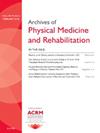Abnormal Prefrontal Functional Network in Adult Obstructive Sleep Apnea – A Resting-state fNIRS Study
IF 3.6
2区 医学
Q1 REHABILITATION
Archives of physical medicine and rehabilitation
Pub Date : 2025-04-01
DOI:10.1016/j.apmr.2025.01.063
引用次数: 0
Abstract
Objectives
To evaluate prefrontal brain network abnormality in adult with obstructive sleep apnea (OSA) based on resting-state functional near-infrared spectroscopy (rs-fNIRS).
Design
This was a cross-sectional study.
Setting
In a general hospital setting.
Participants
Fifty-two subjects, including 27 with OSA and 25 healthy controls (HC) were recruited PSG monitored apnea-hypopnea index (AHI) ≥5 times/h, accompanied by daytime sleepiness and other symptoms. All participants in both groups were right-handed, had no history of nervous system or mental illnesses (including brain trauma), and had not taken psychotropic drugs or consumed substances such as sleeping pills, alcohol, or coffee within 24 hours before the examination.
Interventions
Assessment of a 3-minute resting-state prefrontal cortex (PFC) activity with the fNIRS technique. Only the oxygenated hemoglobin (HbO2) signal was used to calculate resting-state functional connectivity (RSFC) and construct a brain connection network.
Main Outcome Measures
The differences between the patients with OSA and HC group were compared in connection edge number and graph-based indicators. The correlation between these network indicators and also the cognitive performance were also calculated.
Results
Compared with the HC group, patients with OSA showed widely decreased connection edge number, especially in the connection between the right medial frontal cortex (MFG-R) and other right-hemisphere regions. Graph-based analysis revealed that patients with OSA had lower global efficiency, local efficiency, and clustering coefficient than the HC group. Further, both of connection edge number and graph-based indicators were significantly positive correlation with the Montreal Cognitive Assessment score in patients with OSA.
Conclusions
This study suggests that the prefrontal brain network may be impaired in patients with OSA and that this impairment is associated with cognitive performance, as measured by rs-fNIRS. These findings provide initial evidence that prefrontal rs-fNIRS could be a useful and powerful tool for objectively and quantitatively assessing cognitive function impairment in patients with OSA.
Disclosures
none.
成人阻塞性睡眠呼吸暂停的前额叶功能网络异常-静息状态fNIRS研究
目的基于静息状态功能近红外光谱(rs-fNIRS)评价成人阻塞性睡眠呼吸暂停(OSA)患者前额叶脑网络异常。这是一项横断面研究。在一般的医院环境中。纳入52例受试者,其中OSA患者27例,健康对照(HC) 25例,PSG监测呼吸暂停低通气指数(AHI)≥5次/h,伴有白天嗜睡等症状。两组的所有参与者都是右撇子,没有神经系统或精神疾病史(包括脑外伤),在检查前24小时内没有服用精神药物或消耗安眠药、酒精或咖啡等物质。干预:用近红外光谱技术评估3分钟静息状态前额叶皮层(PFC)活动。仅使用氧合血红蛋白(HbO2)信号计算静息状态功能连接(RSFC)并构建脑连接网络。主要观察指标比较OSA组与HC组患者在连接边数和基于图的指标上的差异。计算了这些网络指标与认知表现之间的相关性。结果与HC组相比,OSA患者的连接边缘数量普遍减少,尤其是右半球内侧额叶皮质(MFG-R)与其他右半球区域的连接边缘数量减少。基于图表的分析显示,OSA患者的整体效率、局部效率和聚类系数均低于HC组。此外,连接边数和基于图形的指标均与OSA患者的蒙特利尔认知评估评分呈显著正相关。结论:本研究表明,OSA患者的前额叶脑网络可能受损,并且这种损害与认知能力有关,通过rs-fNIRS测量。这些发现提供了初步的证据,表明前额叶rs-fNIRS可以作为一种有效的工具,客观、定量地评估osa患者的认知功能障碍。
本文章由计算机程序翻译,如有差异,请以英文原文为准。
求助全文
约1分钟内获得全文
求助全文
来源期刊
CiteScore
6.20
自引率
4.70%
发文量
495
审稿时长
38 days
期刊介绍:
The Archives of Physical Medicine and Rehabilitation publishes original, peer-reviewed research and clinical reports on important trends and developments in physical medicine and rehabilitation and related fields. This international journal brings researchers and clinicians authoritative information on the therapeutic utilization of physical, behavioral and pharmaceutical agents in providing comprehensive care for individuals with chronic illness and disabilities.
Archives began publication in 1920, publishes monthly, and is the official journal of the American Congress of Rehabilitation Medicine. Its papers are cited more often than any other rehabilitation journal.

 求助内容:
求助内容: 应助结果提醒方式:
应助结果提醒方式:


